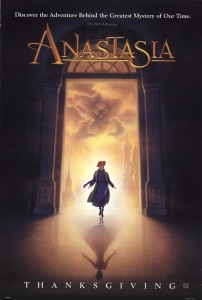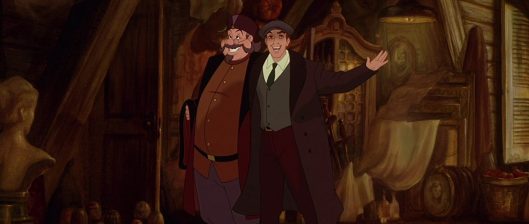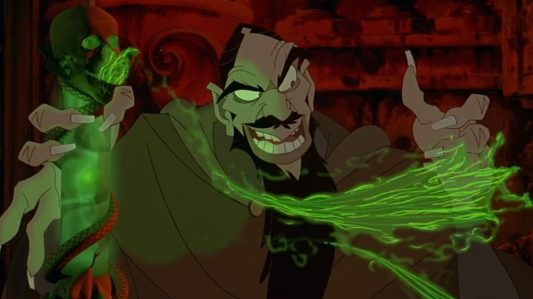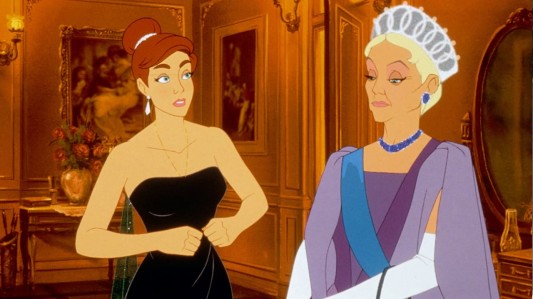REVIEW – Anastasia (1997)
 Directed by: Don Bluth, Gary Goldman
Directed by: Don Bluth, Gary Goldman
Produced by: Don Bluth, Gary Goldman
Screenplay by: Susan Gauthier, Bruce Graham, Bob Tzudiker, Noni White
Edited by: Bob Bender, Fiona Trayler
Score by: David Newman
Songs by: Lynn Ahrens, Stephen Flaherty
Starring: Meg Ryan, John Cusack, Kelsey Grammer, Christopher Lloyd, Hank Azaria, Angela Lansbury, Bernadette Peters, Liz Callaway, Jonathan Dokuchitz, Jim Cummings, Kirsten Dunst, Lacey Chabert
Year: 1997
So it’s pretty much a done deal that Disney is buying out 21st Century Fox and all its assets, so I suppose now is as good a time as any to review Fox’s 1997 Disney cash-in before its parent company’s nuptials to its future evil stepmother takes place, right?
Throughout the 1980s, animators Don Bluth and Gary Goldman had created an identity for themselves as the anti-Disney auteurs, having publically departed from the company in 1979, citing creative differences, to form their own studio, where they produced films like The Secret of NIMH, An American Tail, and The Land Before Time. Many have since gone on to be recognized as animated classics in their own right and for their willingness to address more mature and often darker tone than the traditionally syrupy-sweet fantasy that House of Mouse had largely become known for. However, financial constraints and multiple restructurings led to the duo seeking collaborations with other studios, who seemingly saw it as an opportunity to use the animators as a means of aping Disney in the wake of the huge success of The Little Mermaid and their subsequent animated musicals.
The first of these was Thumbelina, a film distributed by Warner Bros. that not only borrowed from yet another Hans Christian Andersen fairytale but also the voice of Disney’s Little Mermaid herself, Jodi Benson, in the title role. The movie did not perform well, earning $11.4 million on a $28 million budget, and was critiqued for being derivative and its apparent aim to appeal solely to a much younger audience than its more all-ages-friendly Disney counterparts. Subsequent releases A Troll in Central Park and The Pebble and the Penguin eschewed the faux-Disney Princess angle but retained the musical aspects – as well as the studio’s recent trend of bombing financially and critically. Bluth and Goldman’s studio went bankrupt soon after the release of Penguin, a film that both filmmakers themselves disowned midway through production. Hope for the duo, however, was on the horizon in the form of two beaming lights…
Fox’s collaborations with other animation departments had seen diminishing returns since their first and, for a time, only financial success: Fern Gully: The Last Rainforest. As such, they struck a deal with Bluth and Goldman to head up a new animation studio, owned entirely by Fox, in Phoenix, Arizona. Founded in 1994, five years after the release of The Little Mermaid, Fox Animation Studios would similarly struggle to compete with Disney, so much so that it, too, also wound up folding under pressure in 2000 after only two theatrical releases, its final being the cult classic apocalyptic sci-fi adventure Titan A.E. For short a time, however, it really seemed as though Fox may very well have been on track to having the Mouse on the ropes, thanks in large part to Bluth and Goldman’s second attempt to take a page from their playbook in the form of Anastasia.
Nominated for two Oscars (one for Score and another for Original Song), grossing $140 million on a $50 million budget, and acclaimed for breaking the trend of Bluth/Goldman films being merely child-pandering schlock by being actually good, Anastasia really seemed like a comeback story in the making, and it really does hold up much better than a lot of stuff from the ‘90s that has become nostalgia fodder. The film is based on the legend of Anastasia, the daughter of the czar of Russia at the turn of the 20th century who was for a time believed in some circles to have potentially escaped the same deadly fate as the rest of her family in the Russian Revolution. Fox had previously adapted the legend into a 1956 film starring Ingrid Bergman in the lead role, itself based on the 1955 play by Marcelle Maurette, and the animated film largely uses those productions as a guide for its own tale (reportedly – I have personally seen neither), adding plenty of fantasy elements to keep the kids entertained, of course. Don’t expect historical accuracy here. We’re getting into Pocahontas-level territory with this one.
What’s funny is that a lot of the film is actually more focussed on the two conmen, Dimitri and Vlad, both of whom used to work in the palace under the Romanov family before the family’s good time ruling Russia was ruined by a vengeful sorcerer named Rasputin, who sold his soul to unspecified dark forces in return for this favor. (This movie is totally historically accurate, you guys.) Anastasia, as in real life, was rumored to have escaped the same fate as her immediate family, her grandmother having lost her while fleeing the palace amidst the chaos of the political revolution Rasputin conjured into existence. Anastasia falls and hits her head, contracts a case of long-term amnesia, and spends the next ten years living as an orphan named Anya.
Now an adult and on her own, she sets out to find her rightful place in the world, as expressed through a suitably Disney-esque “I want” song, and comes across the aforementioned conmen, Dimitri and Vlad. Hearing that Anastasia’s grandmother is offering a reward for anyone who can reunite her with the princess, the two have been holding auditions for girls who can be coached well enough in their knowledge of the palace and the Romanov family and get them their cash reward. Anya, of course, is the spitting image of Anastasia, and the movie makes it unambiguously clear that that is, in fact, who she is from the very beginning. Much of the movie is thus spent waiting to see how it all plays out, who figures it out first, and just waiting to see how our heroes dispatch with the vengeful and undead Rasputin, who is stuck in limbo with unfinished business, the only one (apart from his wise-cracking bat Bartok) who initially knows of Anya’s true identity.
The movie’s greatest weakness is a lack of stakes. Sure, plenty of things happen that are inherently dangerous throughout the course of the film, but nothing that you don’t know the heroes will escape. The fact that we as an audience know from the outset that Anya is unquestionably the real Anastasia makes the revelations feel anticlimactic. We also know that she’s going to get her happily ever after because, again, this is a ‘90s-era Disney knockoff. Perhaps it’s unfair to expect a family movie to be so ambitious in its storytelling, but I think it would’ve been so much more compelling if the movie had kept her identity a much less obvious inevitability for much of its runtime, even if that was still where it ended up. Don Bluth set out to break the mold with his animated films, and it’s a shame to see him following such formula, down to the presentation. It’s also a shame that by the end of the film, Anastasia largely remains the same person, while the greatest change occurs in Dimitri and Vlad, whose ambitions of extorted riches instead turn into something more altruistic the longer they get to know Anastasia and come to realize who she really is – still unbeknownst to her, by the way.
Despite the movie’s conventionality, though, I will grant that the voice acting, songs, and much of the animation do a lot of heavy lifting in keeping it all very entertaining. This is not a bad movie by any means, and its acclaim at the time and continued admiration is undoubtedly deserved. If Bluth and Goldman were forced into making this imitation, then this is definitely the level of quality you would at least hope for in such a product.
As a character, Anastasia does differentiate herself in her tomboyishness and bluntly sarcastic sense of humor, even if she’s still imitating the Disney mold, down to the sometimes-annoying animal sidekicks. (Why does the dog have a human hairstyle and flutter through the air with its ears!?) She’s even the most active agent in the film’s climax and manages to put the pushy Dimitri in his place on more than one occasion, which isn’t something you’d expect at the time this movie was made. (If only Disney had given Jasmine such a satisfying moment to put her own deceptive love interest in his place as the one Anastasia is afforded here. Such a satisfying moment of physical comeuppance!) A lot of her likability comes from the casting of Meg Ryan at her peak affable Meg Ryanness, but John Cusack and Kelsey Grammer are also charming as Dimitri and Vlad, and the film almost feels like an old-school screwball comedy, which they are all more than capable of performing. To be somewhat nitpicky, though, it is kind of annoying that Vlad, Rasputin, and the grandmother (played by Angela Lansbury) are the only ones with Russian accents, but… you know… whatever. They didn’t spend good money on American sweethearts Ryan and Cuasck in the lead roles only to hide them behind pesky things like accuracy, right?
Christopher Lloyd’s Rasputin is a strange villain, not exactly directly active in the plot until the finale but still ever-present in providing commentary and reactions to his failed spells and the character’s progress along the way. He is afforded a spooky villain song that stands out from the more Broadway-traditional songs elsewhere, though. (Is it me, or did I detect a hint of distorted electric guitar? That’s how you know he’s evil!) It’s left really ambiguous why he’s so hateful towards the Romanovs (Haters gonna hate?), but Lloyd is dependably maniacal (as is Jim Cummings as his singing voice), and his animation is wildly entertaining, particularly during his outbursts that result in amusingly gruesome contortions, including a scene where his head sinks into his ribcage in frustration. Your mileage may vary with Hank Azaria’s comic relief and strangely American-Midwest-accented Bartok. He’s the rare subdued sidekick to the comically mad main villain – think a role reversal of the Iago and Jafar relationship in the apparently oft-comparable Aladdin. I didn’t mind him, exactly, and I love his understated reactions to Rasputin’s more extreme moments, but the movie’s insistence that liking a character means leaving him open to unearned redemption is annoying. That’s hardly Azaria’s fault, though.
So, yeah, Anastasia is hardly Don Bluth and Gary Goldman’s crowning achievement as filmmakers, but in terms of what it sets out to be, it most definitely deserves to be confused with some of their former employers’ better musical films of that era, as it often has been and, I guess, now technically will actually become. While it would have been wonderful to see them play more with the expected tropes and come up with something even a bit more intriguing than what we got, Anastasia remains enjoyable throughout and has enough of its own personality to not feel entirely like a shameless cash-in. The craftsmanship and care put into its production is evident throughout, despite some technical hiccups and dated CGI, and, unlike with Thumbelina, the film doesn’t talk down to its audience, either. If you can set aside any hang-ups you might have about its very loose historical basis, I think you’d be hard-pressed to outright dislike Anastasia.
The Viewer’s Commentary Rating: 3.5 / 5
-
April 23, 2019 at 11:25 amFinal Project / Artist Statement – Maddie's Guide to Disney








